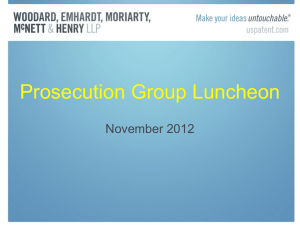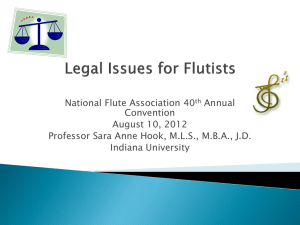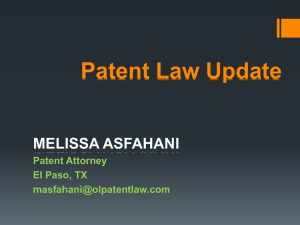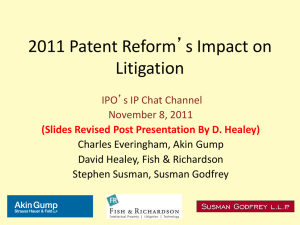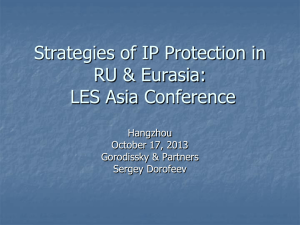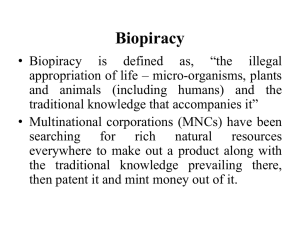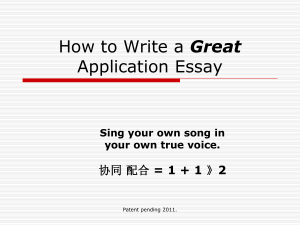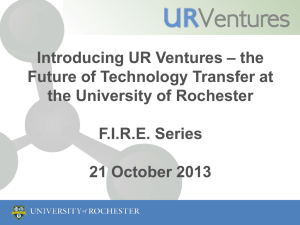Overview of Patent Prosecution
advertisement
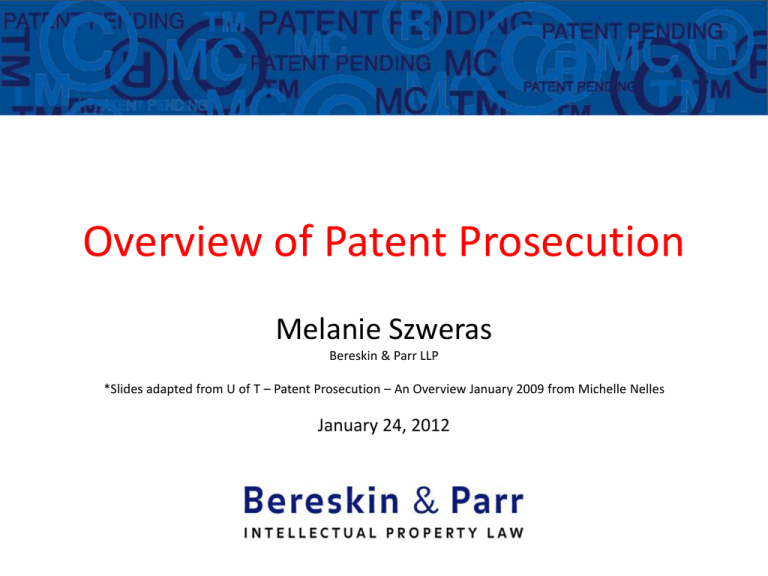
Overview of Patent Prosecution Melanie Szweras Bereskin & Parr LLP *Slides adapted from U of T – Patent Prosecution – An Overview January 2009 from Michelle Nelles January 24, 2012 Canadian Patent Application Process a. Searching b. Preparation 5b. Appeal 1. Filing 2. Publication 3. Request Exam 4. Exam 5a. Allowance 6. Patent Issues Searching • Should conduct prior art search – Guidance as to scope of patent potentially available (broad or narrow patent) – Helps to draft properly (do not want application to read on prior art) – Patentability search different from right to manufacture search • Wise to retain patent counsel to do search Searching • Can search patent databases on Internet but very difficult skill to properly search – – – – USPTO: www.uspto.gov CIPO: www.cipo.ic.gc.ca WIPO: www.wipo.int EPO: www.epo.org • Can search art-specific databases and general Internet searching, for example, on Google • Question to be answered: Is there any other source or combination of sources that disclose what you want to patent? • Usually at least $3000 for a search and verbal opinion • Search has limitations – there is 18-month window until publication in most countries; depends on extent of search, databases searched, keywords used, etc. Canadian Patent Application Process a. Searching b. Preparation 5b. Appeal 1. Filing 2. Publication 3. Request Exam 4. Exam 5a. Allowance 6. Patent Issues Whether/Where to File • Costs associated with patent protection and enforcement are very significant and patents are territorial (basically by country) • Very general estimate: $7-10K for one country (filing cost – does not include prosecution and maintenance ); well over $100K once you consider multi-national filings Whether to File? • scope of patent protection – likelihood of broad or narrow? • commercial life of the invention – can take 35 years at least to get a patent once you request examination • Term of patent 20 years from filing date • Alternative – trade secret Whether to File? • Will the invention be produced by your client or just offered for licensing? • Will competitors be able to design around? – Can take years to get the patent – Market lead time can be significant • Do you have maintain and enforce the patent? – Litigation is prohibitively expensive (often more than $1M for very simple patent in Canada; more in U.S. – note litigation would also be jurisdiction-byjurisdiction) Whether to File? • Are you ready to file the patent – Recall catch 22 of filing too early and not being supported for desired scope of claims • Financing/Licensing – Is a patent application necessary to secure funding? • Defensive Reasons – to scare others away; to preclude others from filing Where to File? • Picking where to file: – Your market – Your manufacturing facilities – Your competitor’s market – Your competitor’s manufacturing facilities – Enforcement potential – Prosecution charges (if budget) The First Filing • Depending on the reason for filing the patent application, the following will affect where you should first file: – Desire for speedy issuance – Indication of patentability – Getting filing date to reserve place in line or due to impending public disclosure Parts of a Patent • • • • • • • • Background Summary Brief Description of the Drawings Detailed Description Claims Abstract Figures Sequence Listing (if present in application) Types of Applications • Full Patent Application – cost for drafting $6,000 to $15,000 • “Short Form” Patent Application – provisional (U.S.) or informal (Canada/UK) – Has to be completed within one year of filing with full application – Can file without claims – Does not save money in long run – more expensive as you still have to prepare a full application at one-year mark – Ballpark cost - ~$3,000 to $8,000 – Good if there is imminent public disclosure or if will take a long time to get to market (provides additional year before clock begins ticking on patent term) Types of Applications • The Patent Cooperation Treaty (PCT) – PCT often called the International Application – Administered by the International Bureau at WIPO – Deemed filing in most countries in the world • BUT: each filing is not crystallized until national phase entry (i.e. filing in each individual country), which must be requested within 30 months • Basically a 30-month delay in deciding where to file in exchange for $4-6K • National phase filings are very expensive and some require translation – In certain countries (like Canada), national phase can be delayed even further – Why delay? Evaluate patentability, market, invention; raise money; license; keep options open Types of Applications • Other Regional Patent Systems (such as Europe) – Can designate over 20 countries – EPO conducts examination and grants patent, which must be perfected or validated in the individual countries where protection is desired – Initial filing cost (not including drafting) is ~$11,000 to $15,000 – General rule of thumb – if interested in more than 3 European countries, better to file with EPO – Some countries require translation – can be expensive ~$100 per page – Validation in 5 countries often at least $20,000 to $30,000 Paris Convention • Foreign Filing and the Paris Convention – Paris Convention gives an applicant one year to file one or more corresponding applications and claim “priority” back to the filing date of the previous application (regular or provisional) – This relieves the applicant of filing in every country in the first instance – Example: Could do U.S. first, and then do PCT Timelines Priority Application 0 National/PCT filings National Phase Entry of PCT filing 12 18 30 Deadline to Request Examination in Canada 72 Months Note: maintenance/renewal fees due throughout depending on country Publication Canadian Patent Application Process a. Searching b. Preparation 5b. Appeal 1. Filing 2. Publication 3. Request Exam 4. Exam 5a. Allowance 6. Patent Issues Patent Application Process • In Canada, an Applicant can file – Applicant can be the inventor or someone who obtained title to the invention from the inventor • In the U.S. – the inventor must apply but then the invention can be sold/assigned to a company • Patent Agent is usually used to draft, file and prosecute a patent – a Patent Agent needs to be appointed if the applicant is not an inventor • Can have joint inventors Timing – Filing an Application • Most countries require absolute novelty – Must have first application on file before any public disclosure • Some countries offer grace period for inventor-derived public disclosures but if desire multi-national protection, should have application on file before first public disclosure (e.g. United States, Canada) Grace Periods • In Canada, you are too late to apply for a patent if: – You waited more than a year to apply after you or your disclosees made the invention available to the public in Canada or elsewhere; (grace period) or – Someone else made it public before your claim date. (absolute novelty) • “Claim date” means the date of a claim in an application for a patent in Canada, as determined in accordance with section 28.1 [Patent Act, s. 2] - (each claim can have own claim date) – Someone else filed for same invention before your claim date/filing date (absolute novelty) How to File in Canada? • Once application has been drafted and approved, need to prepare a petition, which must include: – – – – Title Names and addresses of Applicant and all inventors Priority claim details Pay filing fee • Note: Public Servants Inventions Act – if you are a public servant then must disclose such and cannot file outside of Canada without the Minister’s permission Canadian Patent Application Process a. Searching b. Preparation 5b. Appeal 1. Filing 2. Publication 3. Request Exam 4. Exam 5a. Allowance 6. Patent Issues The Examination Process • Publication – Applications are published or laid-open to the public for public inspection after 18 months from the priority date – Can request earlier publication – e.g. may be preferable if concerned about an infringer as can get reasonable compensation once (s. 55.2 Patent Act) • Examination – – – – Need to request examination (s. 35 Patent Act) Anyone can request examination Requests for examination may be deferred up to 5 years from filing in Canada Currently a delay of about 2-4 years to start examination once it is requested (depends on art) – An Examiner is assigned to the file – should be technically competent –will do a prior art search (for novelty and inventiveness) – Can request expedited examination if you have a reason (like infringer on market) and you pay a fee – Examination is usually faster in the U.S. Patent Office Canadian Patent Application Process a. Searching b. Preparation 5b. Appeal 1. Filing 2. Publication 3. Request Exam 4. Exam 5a. Allowance 6. Patent Issues The Examination Process • What does the Examiner do? – Examiner reviews the application and requisitions compliance with the Patent Act and Patent Rules – Will often issue an Office Action alleging that the application is not allowable (e.g. not new or inventive, claims are unclear, not supported, etc.) – Applicant responds with arguments and/or amendments – Back and forth between Patent Office and Patent Agent (costs can equal cost of application preparation in a difficult matter) – akin to negotiation between Applicant and Patent Office The Examination Process • Amendment is limited – Cannot introduce new subject matter (s. 38.2 Patent Act) – Some jurisdictions need literal support in description (e.g. Europe) • Amendment may broaden or narrow the scope of the claims • Patent to issue to a single invention • May be required to restrict to a single invention and pursue claims to other inventions in additional applications (called divisional applications) Canadian Patent Application Process a. Searching b. Preparation 5b. Appeal 1. Filing 2. Publication 3. Request Exam 4. Exam 5a. Allowance 6. Patent Issues Patent Application Process • Allowance and Issuance – Get Notice of Allowance once approved – Must pay a final fee and then the Patent Office will issue the patent – Need to pay yearly maintenance fees to keep patent in force (timing of maintenance fees may differ by jurisdiction) Patent Application Process • What happens if application is refused by the Patent Office? – When Examiner considers applicant has not traversed a rejection, may make next rejection on the same grounds final – Applicant must amend as required by the Examiner or argue over on next response of the application will go to the Patent Appeal Board – Patent Appeal Board extends opportunity to Applicant to be heard – Commissioner receives Patent Appeal Board’s findings – Decision can be appealed to the Federal Court Patent Application Process • Protests – filing prior art – Third party may file prior art with a statement – Third party involvement is limited – Could actually strengthen a patent • Note: Other jurisdictions (e.g. EPO and soon, the United States) have opposition procedures that allow third parties to be quite involved Patent Application Process • Abandonment and Reinstatement – When Applicant fails to comply with a requirement by the due date, the application becomes abandoned – The Applicant can reinstate the application with 12 months along with completing the original requirement and paying a reinstatement fee Canadian Patent Application Process a. Searching b. Preparation 5b. Appeal 1. Filing 2. Publication 3. Request Exam 4. Exam 5a. Allowance 6. Patent Issues Patent Application Process Post issuance options • Three major provisions available to clean up patent if necessary: 1. Disclaimer • 2. To disclaim (narrow) a part of a patent Re-examination • • • • 3. Re-opens examination Cannot broaden scope of claims Based on prior art Can lead to cancelled, confirmed or amended claims Reissue • • • • Also re-opens examination Can broaden Test is inadvertence, accident or mistake – need to show meant to protect initially 4-year time limit from date of issuance Claim Drafting • Claims: should specify in a positive manner all the elements, features and critical aspects of the invention which are necessary to ensure the result set forth in the description • Directed towards a person skilled in the art • Series of “fences” or “nested fences” Claim Drafting • Each claim is a single sentence – Preamble or introductory phrase – Transitional phrase (e.g. comprising – means including as well as others as opposed to consisting of) – Body – each element that is required – main and sufficient elements should be described Claim Drafting • Clarity of Language – Antecedents – if say “the pencil” must first have used the term “a pencil” – Ambiguous terms must be avoided – e.g. “about”, “substantially”, etc. – Negative limitations should be avoided – Language must be consistent Types of Claims • Independent (broadest) vs. Dependent • Types: – Product or apparatus – System – Process or method – Method of use and use – Markush (selected from the group consisting of…) – Jepson (“the improvement comprising…”) Example • What is the goal or objectives to be achieved? • What is the minimum functions/elements needed to achieve the benefit or advantage? Chair Claim • What are the elements of a chair? – Essential • • Seat Support element – Optional • • • • • • Chair back Additional support elements Wheels Cushion Arm rests What is the function? – Essential • Support a person in a sitting position – Optional • • • Adjustability of seat back Adjustability of height Moveable Chair claims • A chair comprising: a seat; and a vertical element providing support for the seat. • A chair comprising: a seat; and a vertical element providing support for the seat; wherein the vertical element is connected to the underside of the seat; wherein the seat is raised to a position above the ground by the vertical element. Dependent claims • The chair of claim 1, wherein the seat comprises a cushion. • The chair of claim 1 or 2, wherein the support comprises a plurality of vertical elements. Thank You Melanie Szweras mszweras@bereskinparr.com Bereskin & Parr LLP

